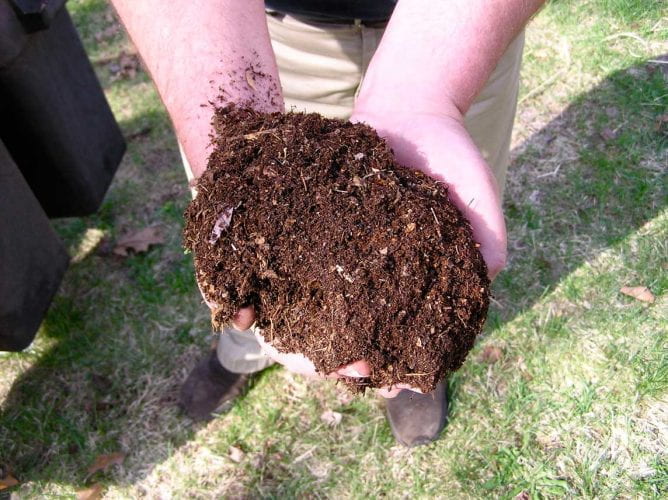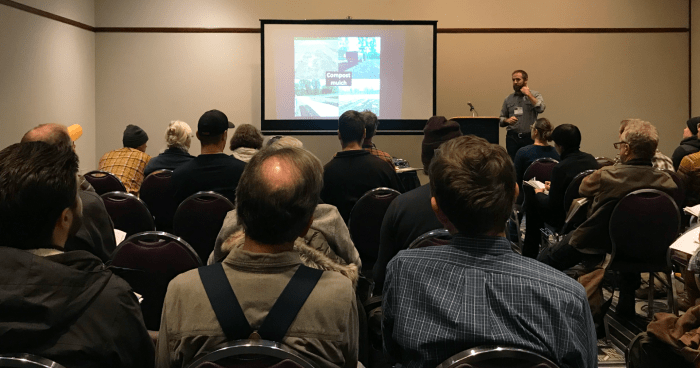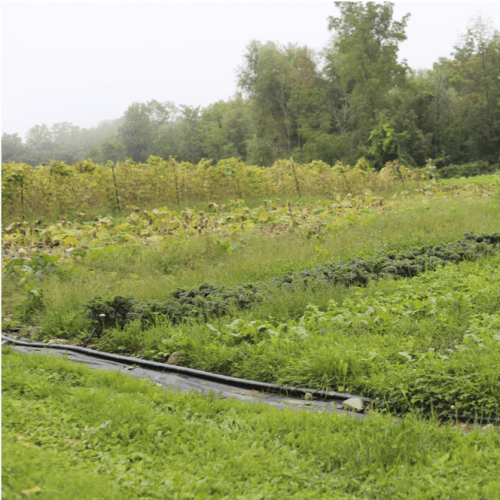
By Kitty Gifford and Haley Rylander
Compost can do more than improve soil quality, it can also help suppress weeds when used as a mulch, especially in reduced-tillage vegetable systems. Deep composting, a method to use compost applied thickly, like a mulch, was presented in a workshop at the 38th annual Northeast Organic Farming Association of New York’s (NOFA-NY) Winter Conference.
A Cornell University team, along with invited farmers, led the workshop:
- Haley Rylander, extension support specialist with New York Soil Health
- Jean Bonhotal, director of the Cornell Waste Management Institute
- Ryan Maher, research and extension specialist at Cornell Small Farms Program
“As more and more farmers adopt reduced tillage practices, especially on smaller-scale organic farms, the challenge of suppressing weeds can prove inhibitive to success,” said Rylander. “Applying plant-based mulch to the soil is one way farmers suppress weeds in reduced-till systems. More recently, some farmers have begun to use a different type of mulch: compost.”
More than 1,100 people attended the January 17-19th conference held at the Oncenter in Syracuse, NY. The conference focuses on organic farming and sustainable farming practices, offers over 100 workshops, and brings in over 60 trade show vendors.
Many organic farmers already apply compost to the soil to increase nutrients and organic matter. The concept of compost mulch is different: apply one to four inches of compost to the surface of the soil, and plant crops directly into the compost. This thick layer of compost can bury weed seeds, block light from living weeds, and add organic matter and nutrients to the soil. Farmers have been adopting this practice to facilitate reduced-till or no-till on their farms, and many have had success.
There has been limited research in this practice, and farmers were interested in learning about different compost sources, types, and application methods, compost impacts on soil nutrients and weeds, and how to make their own compost.
No farming practice solves all problems without a catch, however. A few inches of compost may not sound like a lot, but mulching one acre with 1.5 inches of compost takes about 70 fresh tons of compost. Even for farms that are a few acres or less, sourcing enough quality compost year after year can prove challenging and expensive. Reflecting on a recent farm trial, Liz Martin at Muddy Fingers Farm in Hector, NY, shared her concerns with sourcing compost and the upfront labor needed to apply high rates of compost, especially at busy planting times.
Aside from economics and logistics, excessive composting can have negative environmental impacts as well. Most compost, especially manure-based compost, is high in phosphorus. While high concentrations of phosphorus in the soil are not likely to hurt plants, they can only use so much phosphorous, and the rest will build up and is more likely to leave the farm in runoff water. The story is similar for other nutrients – when using compost as mulch, nutrients are being applied well over crop needs.
Phosphorus runoff is already a common issue with livestock operations and farms that fertilize with manure, and the effects are widely studied. When high concentrations of nutrients, including phosphorous, enter lakes and streams, aquatic plant life, namely algae, experiences sudden increases in growth, sapping all the oxygen from the water and causing fish kills and dead zones through a process called eutrophication.

Ryan Maher, research and extension specialist at Cornell Small Farms Program, presenting at the NOFA-NY winter conference. Photo: Haley Rylander
Using compost as a mulch significantly increases phosphorus concentrations in the soil. In a study headed by Ryan Maher with the Cornell Small Farms Program, permanent beds received 1.5 inches of compost every year for four years. In these beds, phosphorous in the top eight inches of soil increased from <5 ppm in 2014, to 80 ppm in 2017. In those same plots, organic matter increased from 4% to 7%. These are drastic changes in soil chemistry after only three years.

Muddy Fingers, an organically practicing mixed vegetable farm, was one of the case study sites for monitoring deep compost use.
“Farmers are literally feeling the benefits of compost mulch, easier planting and weeding in no-till conditions, but we should consider the risks of nutrient loading, and bringing together farmers to learn and talk more about the tradeoffs will hopefully help us advance and improve no-till systems,” says Maher.
Even one year of using compost mulch can affect the soil. New York Soil Health tested two farms in 2019 on which farmers had recently used one or more inches of compost in vegetable beds. On both farms, organic matter concentration increased 2% compared to non-composted beds, and already high phosphorus levels more than doubled (~70 ppm to 165 ppm).
One way to stay smart about compost mulch is by regularly testing the compost and soil to monitor phosphorus and other nutrient concentrations. Farmers can apply compost mulch only some years, use a compost that is lower in phosphorus, and look for ways to dial back rates over time. Plant, wood, and food-based composts tend to have much less phosphorus than manure-based composts and can help mitigate high phosphorus levels in the soil.
While compost mulch is increasingly seen as a way to suppress weeds and help reduce tillage on small acreage, farmers should use caution when applying such large amounts of compost to the soil. More research and sharing of farmer experiences will help move these systems forward. Using other methods of weed suppression, such as tarping and cover crops to keep soils covered, could be strategies to lower compost rates while holding nutrients in place, and help farmers improve their compost use with less tillage.
This story also appeared in the Morning AgClips.